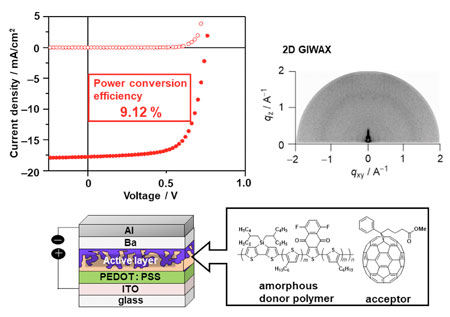| Posted: Jan 25, 2018 |
A simple new approach to plastic solar cells
(Nanowerk News) Humankind is in the midst of a massive drive to harness solar energy to power our homes, gadgets, and industry. Plastic solar cells, based on blends of conducting organic polymers, are of interest for making lightweight and cheap solar cells. The problem with these kinds of solar cells is that their solar power efficiencies are very closely related to the way the different types of materials mix and crystalize in thin films. This means complex and careful processing is usually needed to make efficient polymer solar cells.
|
|
Now, researchers at Osaka University, in an international collaboration with Max Planck Institute for Polymer Research, have redesigned one of their previously reported polymers to make a new kind of solar cell that needs no extra special treatments.
|
|
They also managed to keep excellent power conversion efficiency of solar power to electricity, as recently reported in Advanced Energy Materials ("Enhanced Photovoltaic Performance of Amorphous Donor- Acceptor Copolymers Based on Fluorine-Substituted Benzodioxocyclohexene-Annelated Thiophene").
|
 |
| Current density-voltage characteristics of organic solar cell and X-ray pattern of active layer. (Image: Osaka University)
|
|
"Conventional organic solar cells have now achieved good efficiencies but the polymer films in these devices typically require special processing to ensure correct crystallization. Instead, we have been focusing on amorphous polymer blends to avoid these issues," lead author Yutaka Ie says.
|
|
Organic solar cells work based on light energy exciting electrons in a polymer. The excited electrons can then transfer to a soccer ball-shaped fullerene and move to the positive side of the solar cell. The space left by an electron is known as a hole. It too must move through the polymer to the other side of the device to complete the circuit.
|
|
The Osaka researchers knew that one of their polymers could not transport holes so effectively. They redesigned the structure by adding an extra component, which improved its hole conductivity, and in turn enhanced the solar power conversion performance.
|
|
Coauthor Yoshio Aso says, "Being able to make these cells without having to pay such close attention to the crystal structure of the polymer films could allow us to mass produce these devices by simple printing methods, which should considerably lower costs of the devices and lead to much wider uptake."
|

